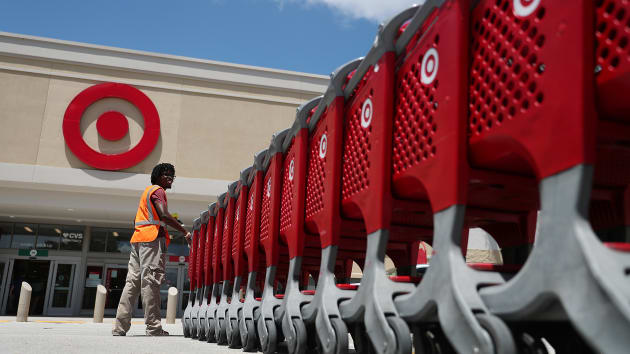Target said Wednesday it is raising its minimum wage to $15 per hour and will give all hourly employees a one-time bonus of $200.
The $2 per hour raise will apply to employees at stores and distribution centers, beginning July 5. Target had temporarily raised its wages by $2 an hour in March as coronavirus cases rose.
The bonuses, which recognize part-time and full-time employees’ work during the pandemic, will be paid out at the end of July, according to the company, which has more than 350,000 employees and nearly 1,900 stores across the U.S.
Target’s announcement is the culmination of several years of raising employee pay. Three years ago, the retailer announced a plan to increase its starting hourly pay from $10 to $15 over three years. It raised the minimum wage to $13 an hour last June and pledged to raise it to $15 an hour by the end of 2020.
The company is extending benefits it began offering during the pandemic, including free backup care for employees’ children or needy adults through August, free mental health counseling and 30-day paid leave for employees at higher risk of Covid-19.
Starting this week, it added a new benefit: All employees can get free access to virtual doctor visits through the end of the year, even if they do not get health insurance through Target.
The change in minimum wage will effectively give a raise to about 275,000 of its employees, the company said. Employees in some cities, such as New York City and San Francisco, already had wages of at least $15 an hour.
Target is one of the retailers that kept its doors open to sell essential items from groceries to toilet paper during stay-at-home orders. As employees continued to come to work and took on new tasks, such as sanitizing and frequently restocking shelves, Target announced a temporary pay increase of $2 an hour to at least $15 in March, and it was extended through July 4.
Also in March, the retailer paid bonuses of $250 to $1,500 to 20,000 hourly team leaders who oversee store departments.
With the higher wages, Target is spending nearly $1 billion more this year than it did last year on employee-related expenses, including many tied to the pandemic. It has expanded paid leave for employees during the Covid-19 crisis, bought protective equipment for them and donated $1 million to the Target Team Member Giving Fund, which helps workers with unexpected financial hardships.
Target’s margins have been under pressure from pandemic-related expenses. Along with added labor costs, the company sold fewer high-margin items, such as apparel and accessories, in the first quarter. Customers’ shift to online shopping cut into profits, too, as the company had to ship more items to homes or get them ready for curbside pickup.
CEO Brian Cornell told reporters during an earnings call in May that the cost of increased wages, store cleaning and special benefits like additional child care totaled about $500 million in its fiscal first quarter, which ended May 2. That included the $2 per hour wage increases and improved benefits that extended through early July.
Target is catching up with some rivals and increasing the pay gap with others. Hourly wages at Walmart start at $11 an hour. At Amazon, wages start at $15 an hour. The federal minimum wage is $7.25. It was last increased in 2009, but some states and cities have set the bar higher than the federal requirement.
Target is raising wages at a time when protesters across the country are pressing for racial equity. Along with calling for justice in the death of George Floyd at the hands of police, they’ve raised questions about the role of corporations in expanding economic opportunity — particularly for Black Americans and essential workers who make little pay but have risked their lives during the pandemic, such as those at grocery stores and nursing homes.
Before the pandemic, as unemployment in the U.S. dropped to the low single-digits and made it hard for employers to fill jobs, salaries crept higher and companies sweetened employee benefits to attract workers. For example, Walmart began subsidizing college for employees and charging them just $1 a day for tuition.
Since then, however, efforts to slow the spread of the coronavirus have temporarily closed stores and restaurants and led to millions of layoffs and furloughs. As states ease restrictions, some workers may be rehired but unemployment is expected to remain higher than before the virus struck for some time.

